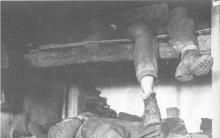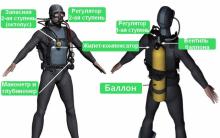In addition to combat operations and the constant proximity of death, there is always another side to war - the everyday life of army life. A man at the front not only fought, but was also preoccupied with an endless number of things that he needed to remember.
Without good organization of life for military personnel in a combat situation, one cannot count on the successful completion of the assigned task. As you know, the morale of the soldiers was greatly influenced by the organization of everyday life. Without this, during combat operations, a serviceman cannot restore the expended moral and physical strength. What kind of restoration of strength can a soldier expect if, for example, instead of healthy sleep during rest, he scratches violently to get rid of the itching? We tried to collect interesting photographs and facts of front-line life and compare the conditions in which Soviet and German soldiers fought.
Soviet dugout, 1942.
.jpg)
German soldiers at a standstill, Central Front, 1942-1943.
.jpg)
Soviet mortar men in a trench.
.jpg)
German soldiers in a peasant hut, Central Front, 1943.
.jpg)
Cultural service for Soviet troops: front-line concert. 1944
.jpg)
German soldiers celebrate Christmas, Central Front, 1942.

Senior Lieutenant Kalinin's soldiers get dressed after the bath. 1942
.jpg)
German soldiers at dinner.

Soviet soldiers at work in a field repair shop. 1943
.jpg)
German soldiers clean shoes and sew up clothes.
.jpg)
First Ukrainian Front. General view of the regimental laundry in the forest west of Lvov. 1943
.jpg)
German soldiers at a rest stop.
.jpg)
Western Front. Haircut and shaving of Soviet soldiers in a front-line barbershop. August 1943.
.jpg)
Haircut and shaving of German army soldiers.
.jpg)
North Caucasus Front. Girls fighters in leisure hours. 1943
.jpg)
German soldiers in their free time at a rest stop.
Much in a soldier’s life, and even at the front, depended on uniforms. From the memoirs of Ivan Melnikov, a soldier of the Leningrad Front of the 1025th separate mortar company: “We were given underpants, a shirt, a cloth tunic, a padded jacket and cotton trousers, felt boots, a hat with earflaps, and mittens. In such uniforms it was possible to fight even in forty-degree frosts. In contrast from us, the Germans were dressed extremely lightly. They were dressed in overcoats and caps, boots. In especially severe frosts, they wrapped themselves in woolen scarves, wrapped their legs in rags, newspapers, just to save themselves from frostbite. This was the case at the beginning of the war near Moscow and later - near Stalingrad. The Germans were never able to get used to the Russian climate."

Western Front. Soviet soldiers during leisure hours on the front line. 1942
.jpg)
Absentee (by correspondence) marriage of a German soldier. The ceremony is performed by the company commander, 1943.
.jpg)
Operation in a Soviet field hospital, 1943.
.jpg)
German field hospital, 1942.
One of the main issues of military life was supplying the army and military rations. It is clear that you cannot fight much if you are hungry. Daily rate of food distribution for the Wehrmacht ground forces per day as of 1939:
Bread................................................. ........................... 750 grams
Cereals (semolina, rice)................................... 8.6 grams
Pasta................................................. ............... 2.86 grams
Meat (beef, veal, pork)....... 118.6 grams
Sausage................................................. ................. 42.56 grams
Salo-lard................................................... ............... 17.15 grams
Animal and vegetable fats........................ 28.56 grams
Cow butter................................................... ....... 21.43 grams
Margarine................................................. ............... 14.29 grams
Sugar................................................. .................... 21.43 grams
Ground coffee................................................ ......... 15.72 grams
Tea................................................. ....................... 4 grams per week
Cocoa powder........................................................ ......... 20 grams (per week)
Potato................................................. ............. 1500 grams
-or beans (beans)................................... 365 grams
Vegetables (celery, peas, carrots, kohlrabi)........ 142.86 grams
or canned vegetables........................ 21.43 grams
Apples................................................. ................... 1 piece per week
Pickles................................................ ..... 1 piece per week
Milk................................................. ............... 20 grams per week
Cheese................................................. ....................... 21.57 grams
Eggs................................................. .................... 3 pieces per week
Canned fish (sardines in oil).................................. 1 can per week

German soldiers at a rest stop.
The daily ration was given to German soldiers once a day in its entirety, usually in the evening, at nightfall, when it became possible to send food bearers to the near rear to the field kitchen. The soldier determined the place of meals and the distribution of food products during the day independently.

During the Great Patriotic War, the fascist troops fighting on the Eastern Front revised the standards for the distribution of food, the supply of uniforms and shoes, and the consumption of ammunition. Their reduction and reduction played a certain positive role in the victory of the Soviet people in the war.

German soldiers during a meal.
Large containers equipped with shoulder straps were used to deliver food from the field kitchen to the fascist front line. They came in two types: with a large round screw cap and with a hinged lid that fit the entire cross-section of the container. The first type was intended for transporting drinks (coffee, compotes, rum, schnapps, etc.), the second - for such dishes as soup, porridge, goulash.

The daily norm for the distribution of food to the Red Army soldiers and the commanding personnel of the combat units of the active army of the Soviet Union as of 1941:
Bread: October-March........................900 grams
April-September...................800 grams
Wheat flour, 2nd grade.............20 grams
Various cereals........................140 grams
Pasta...................................30 grams
Meat........................................150 grams
Fish........................................100 grams
Combine fat and lard...........................30 grams
Vegetable oil...................20 grams
Sugar.........................................35 grams
Tea........................................1 gram
Salt........................................30 grams
Vegetables:
- potatoes........................500 grams
- cabbage...................................170 grams
- carrots........................................45 grams
- beets...........................40 grams
- onion...................................30 grams
- greens........................................35 grams
Shag..........................................20 grams
Matches.........................3 boxes per month
Soap...................................200 grams per month

June 1942. Sending freshly baked bread to the front line
It is worth noting that food standards did not always reach the fighters in full - there was simply not enough food. Then the senior officers of the units gave out 900 grams of bread instead of the established one, for a total of 850, or even less. Such conditions encourage the unit's command to use the help of the local population. And in difficult combat conditions, unit commanders often did not have the opportunity to pay due attention to the catering department. No duty personnel were assigned, and basic sanitary conditions were not observed.

Field kitchen of Soviet soldiers.

Soviet soldiers during a meal.
Materials used when writing this article
Soldiers' tales are an invariable attribute of Russian folklore. It just so happened that our army fought, as a rule, not “thanks to”, but “in spite of”. Some stories from the front make us open our mouths, others cry out “come on!?”, but all of them, without exception, make us proud of our soldiers. Miraculous rescues, ingenuity and just luck are on our list.
With an ax on a tank

If the expression “field kitchen” only makes you increase your appetite, then you are not familiar with the story of the Red Army soldier Ivan Sereda.
In August 1941, his unit was stationed near Daugavpils, and Ivan himself was preparing lunch for the soldiers. Hearing the characteristic clang of metal, he looked into the nearest grove and saw a German tank driving towards him. At that moment he only had an unloaded rifle and an ax with him, but Russian soldiers are also strong in their ingenuity. Hiding behind a tree, Sereda waited for the tank with the Germans to notice the kitchen and stop, and that’s what happened.
The Wehrmacht soldiers climbed out of the formidable vehicle, and at that moment the Soviet cook jumped out of his hiding place, waving an ax and a rifle. The frightened Germans jumped back into the tank, expecting, at a minimum, an attack by an entire company, and Ivan did not try to dissuade them from this. He jumped on the car and began to hit its roof with the butt of an ax, but when the taken aback Germans came to their senses and began to shoot at him with a machine gun, he simply bent its barrel with several blows of the same ax. Feeling that the psychological advantage was on his side, Sereda began shouting orders to the non-existent reinforcements of the Red Army. This was the last straw: a minute later the enemies surrendered and, at carbine point, set off towards the Soviet soldiers.
Woke up the Russian bear

KV-1 tanks - the pride of the Soviet army in the early stages of the war - had the unpleasant property of stalling on arable land and other soft soils. One such KV was unlucky to get stuck during the retreat of 1941, and the crew, loyal to their cause, did not dare to abandon the vehicle.
An hour passed and German tanks approached. Their guns could only scratch the armor of the “sleeping” giant, and having unsuccessfully shot all the ammunition at it, the Germans decided to tow the “Klim Voroshilov” to their unit. The cables were secured, and two Pz IIIs moved the KV from its place with great difficulty.
The Soviet crew was not going to give up, when suddenly the tank's engine started up, grunting with displeasure. Without thinking twice, the towed vehicle itself became a tractor and easily pulled two German tanks towards the Red Army positions. The puzzled crew of the Panzerwaffe was forced to flee, but the vehicles themselves were successfully delivered by the KV-1 to the very front line.
Correct bees

The battles near Smolensk at the beginning of the war claimed thousands of lives. But more surprising is the story of one of the soldiers about the “buzzing defenders.”
Constant air raids on the city forced the Red Army to change their positions and retreat back several times a day. One exhausted platoon found itself not far from the village. There, the battered soldiers were greeted with honey, fortunately the apiaries had not yet been destroyed by airstrikes.
Several hours passed, and enemy infantry entered the village. The enemy forces outnumbered the Red Army forces several times and the latter retreated towards the forest. But they could no longer save themselves, they had no strength, and the harsh German speech could be heard very close by. Then one of the soldiers began to turn over the hives. Soon a whole buzzing clump of angry bees was circling over the field, and as soon as the Germans came a little closer to them, a giant swarm found its victim. The enemy infantry screamed and rolled across the meadow, but could not do anything. So the bees reliably covered the retreat of the Russian platoon.
From the other world

At the beginning of the war, fighter and bomber regiments were separated and often the latter flew on missions without air protection. This was the case on the Leningrad Front, where the legendary man Vladimir Murzaev served. During one of these deadly missions, a dozen Messerschmitts landed on the tail of a group of Soviet IL-2s. It was a disastrous situation: the wonderful IL was good in every way, but was not very fast, so having lost a couple of aircraft, the flight commander ordered the aircraft to be abandoned.
Murzaev was one of the last to jump, already in the air he felt a blow to the head and lost consciousness, and when he woke up, he mistook the surrounding snowy landscape for the Gardens of Eden. But he had to lose faith very quickly: in heaven there probably are no burning fragments of fuselages. It turned out that he was lying just a kilometer from his airfield. Having hobbled to the officer's dugout, Vladimir reported his return and threw a parachute onto the bench. Pale and frightened fellow soldiers looked at him: the parachute was sealed! It turns out that Murzaev was hit in the head by part of the plane's skin, and his parachute did not open. The fall from 3500 meters was softened by snowdrifts and true soldier's luck.
Imperial cannons

In the winter of 1941, all forces were thrown into defending Moscow from the enemy. There were no extra reserves at all. And they were needed. For example, the Sixteenth Army, which was drained of blood by losses in the Solnechnogorsk region.
This army was not yet led by a marshal, but already by a desperate commander, Konstantin Rokossovsky. Feeling that without an extra dozen guns the defense of Solnechnogorsk would fall, he turned to Zhukov with a request for help. Zhukov refused - all forces were involved. Then the tireless Lieutenant General Rokossovsky sent a request to Stalin himself. The expected, but no less sad, answer came immediately - there was no reserve. True, Joseph Vissarionovich mentioned that there may be several dozen mothballed guns that took part in the Russian-Turkish War. These guns were museum exhibits assigned to the Dzerzhinsky Military Artillery Academy.
After several days of searching, an employee of this academy was found. An old professor, almost the same age as these guns, spoke about the conservation site of howitzers in the Moscow region. Thus, the front received several dozen ancient cannons, which played an important role in the defense of the capital.













By its nature, the German nation is very different from all others. They consider themselves highly educated people for whom order and system are above all else. As for the German fascists led by Fuhrer Hitler, who wanted to take over the whole world, including the Soviet Union, it is worth saying that they revered only their nation and considered it the best of all others. During the Great Patriotic War, the Nazis, in addition to burning cities and exterminating Soviet soldiers, found time to entertain themselves, but not always in humane ways.
The Great Patriotic War suffered many events that left their indelible mark on the history of mankind. Active hostilities took place constantly, only the locations and military personnel changed. In addition to the defeats, bombings and battles of the Red Army soldiers and the fascist invaders, at the moments when the explosions subsided, the soldiers had the opportunity to rest, replenish their strength, eat and have fun. And in such a difficult time for everyone, the soldiers, who constantly walked close to death, saw how their colleagues and just friends were killed before their eyes, knew how to rest, abstract themselves, sing war songs, write poems about war, and just laugh at interesting stories.
But not all entertainment was harmless, because everyone has a different understanding of fun. For example, Germans throughout the Second World War they showed themselves to be brutal killers, sparing no one on their way. According to many historical facts and testimonies of older people who themselves witnessed that terrible period of time, it can be stated that all the actions of the Nazis were not so forced; many actions were carried out on their personal initiative. Killing and torturing many people became a kind of fun and games. The fascists felt their power over other people, and to assert themselves they committed all the most brutal crimes that were not punished in any way.
It is known that in occupied territories, enemy troops took civilians hostage and covered them with their bodies, and then executed them. People were killed in gas chambers and burned in crematoria, which at that time worked without interruption. The punishers spared no one. The executioners shot, hanged and burned alive small children, women, and old people and took pleasure in it. How this is possible is inexplicable to this day and it is unknown whether all these brutal historical mysteries will ever be solved. One of the ways of entertainment of the German fascists was the rape of women and little girls. Moreover, this was often done collectively and very cruelly.
Photographs from the Great Patriotic War show that the Germans were engaged in hunting, and were very proud of their trophies. Probably, hunting and fishing were just entertainment for the Nazis, since they were fed much better than Soviet soldiers. The Nazis especially loved to hunt large animals, wild boars, bears and deer. Germans They also loved to have a good drink, dance and sing. Since they are an extraordinary people, they came up with appropriate activities, which is clearly shown in many photographs. The German fascists undressed and took away cars and strollers from civilians and posed with them. Also Nazis they loved to pose with the ammunition that was used to destroy the glorious Soviet people.
However, in addition to all the worst things, there is an opinion that not all German invaders were cruel and merciless. There are many documented testimonies that state that the Germans even helped some families and elderly people with whom they lived during the occupation of Soviet territories.
Be that as it may, there will never be a good attitude towards the fascists. There is no forgiveness for such bloody actions.
) and I’m posting interesting photos for you from 1941-45
Today I found a disk with photos from satellite fishing. I saw this folder about how the Germans had fun during the war, after the battles. The funny shots will surprise you, I think. Of course, there are photographs that many will think: well, he showed this here on the forum... But I think history is not a shame or falsehood, history should be impartial, the same as captured by the photographer of that time!
By the way, what is satellite fishing? It's free to rob from a satellite. I did this for a while, I got carried away. Someone is downloading this via satellite Internet, and I wedge myself into the stream and download it for myself too! I set catch jepeg, avi, dvd from zero to infinity (file size catch). It was great, but tiring... During the night I “stole” 15-20 gigs in total. It took an hour and a half to sort and look. You quickly get fed up with pleasure... Someday I will tell you here what satellite fishing is and what you need to do at home in order to download for free from any satellites.
I reduced the photos for you and posted them here in this thread. Photos of fascists having fun after battles, laughing, making fun of their friends - it’s so interesting to see all this 60 years later! Of course, Germans are people too, and all people tend to joke and have fun in their free moments from fighting. After all, to survive and enjoy every day when you are alive is immeasurable happiness...
Take me for a ride, buddy! A fascist sits on a baby stroller, barely able to fit his seat

The German is trying something, apparently the cook. And his friends grin when they see his sour expression

Interesting photo shoot of naked Wehrmacht soldiers! Helmets, machine guns in hand and grins, like we can’t do that yet...

Like a Hercules with a cigarette in his mouth at war!

Apollo, your mother, covered the most secret things with a “fig leaf” (burdock). A knife-bayonet on the side, always ready for battle...

The hunt was a success... Apparently, north. Perhaps where is Murmansk or where is the Kola Peninsula.

And we don’t care about military service! Long and short. The photographer clearly makes it known that it is an honor to serve in the German army. And after more than 60 years, this is funny to us. Imagine for a moment, the trench dug by the tall soldier on the right is too big for the short one? How to get out of it in battle and run into the attack with everyone???? Imagine for a moment his attempts to get out of a deep hole?

And now it’s the other way around! Fat and skinny! At first I thought that Hitler was standing on the right as a child) But I saw the insignia, this is clearly a soldier wearing a mustache ala Fuhrer Hitler! Imitates, so to speak. A covert parody of the opposites in the German army. Do you think this photo shows us the essence?

Russian bear and the German conquerors. Please note - the sign shows that Leningrad is 70 km away

It's time... A fascist shitting with a cigarette in his mouth) The photographer caught a good moment from the wrong side of the war...

Cultural performance for the Germans after the battle...

Soon this little pig will go into the pan and feed all the German pilots...

Faithful friends

Touching the squirrel

We must drink to the successful invasion... The soldier is clearly posing with a bottle in his hand, sitting astride a bust of Stalin.

Eh, horse racing))) On Russian carts in the steppes of Ukraine or in the Kuban region











Imposing the Bashkir language is illegal!
National media: priorities have been set, state support will be provided Rospechat socially significant projects
Why do you dream of a wooden house - interpretation of the dream from dream books
Setting up correct correspondence accounts Correct postings in 1s bp 3
We organize proper accounting of accepted obligations